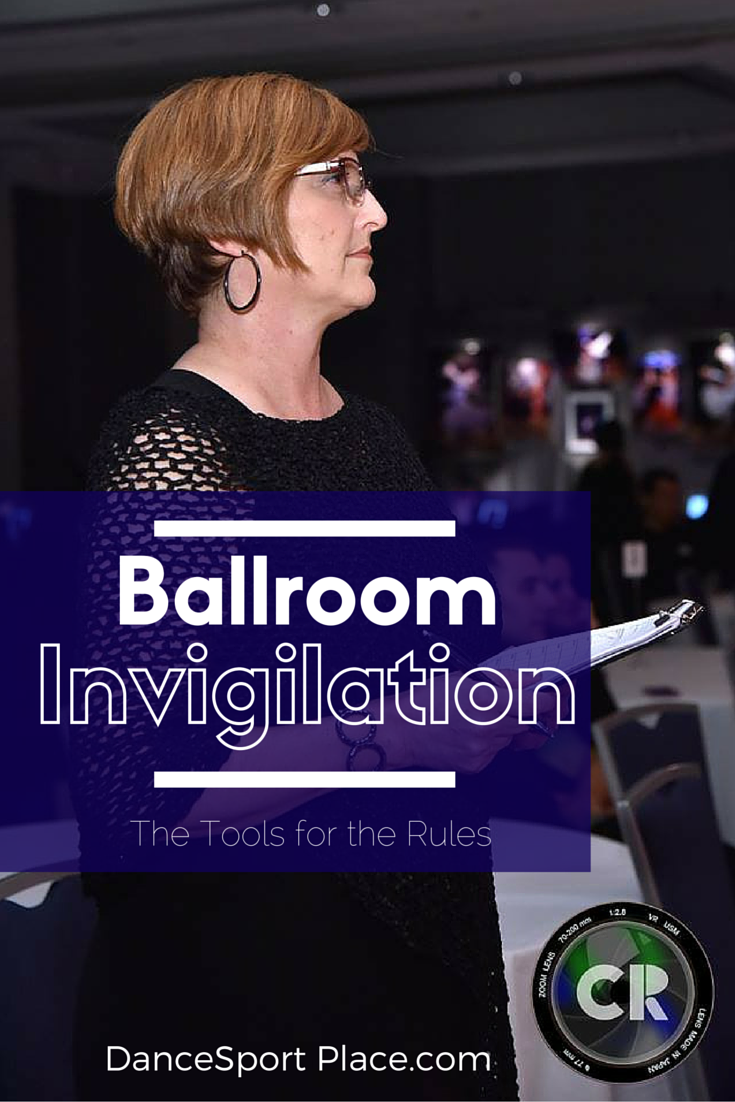What is important about ballroom invigilation? First, it keeps us “honest” with our students (and ourselves) when we enter competitions. Adherence to the allowed step patterns and restrictions helps promote a logical advancement for the students, levels the competitive playing field and allows judges to focus on assessing HOW the dancers are dancing and not WHAT the dancers are dancing.
Second, it’s an important learning opportunity. Education happens most often in the studio, but valuable information can be learned from the invigilation process. How the invigilator and the competitor approach invigilation can be one of the most positive and productive means of learning and that gets passed on to the students.
“Restricted” step lists are actually not as limiting as they seem, and even with syllabi that have been codified for a long time there can be a lot of creativity in choreography and dancing.
If styling a step pattern doesn’t detract from the nature of the figure, go for it! But be aware of the guidelines and then just relax and have fun.
The more fun you have, the more your students will enjoy the competition and learning processes, the better YOU make the industry!

Photo used with permission. © Charles Ryder Photography
Included in the most common infractions are some important factors.
1. Not reading the list of step patterns and restrictions.
This is shockingly common! As an invigilator, I regularly say things like “just a reminder, the blah blah blah step is not a Bronze level figure.” Often, I’m addressing a seasoned competitor who really does know what s/he is doing, but is either careless with the syllabus or hasn’t kept up with recent (within the last 20 years) changes.
Two of the more common infractions are using an Open Hip Twist in Bronze International Cha Cha and Rumba, and using a Running Finish in International Waltz or Foxtrot. Nope. Sorry. Read the list!
2a. Not understanding the list of steps and restrictions.
This happens frequently with professionals who are under- or self-trained and may lack the necessary structure in their own learning process. That unfortunately reflects on the student. Adept technical skills, musicality, fluidity of routines, quality of movement and performance combine to make great dancing. Under-trained professionals under-train their students.
2b. Not understanding the list of steps and restrictions due to a language barrier.
This is another point where the invigilation process is a valuable learning tool. We can help! We have resources and want to make your job easier. Ask.
3. Professionals who do not take responsibility for their own training.
Professionals may book lessons with outside coaches to get a routine for their students, neglecting to mention a specific level. The choreography may seem simple to the professional, but may not be syllabus compliant. The professional then passes the “blame” for non-syllabus compliant routines on to the coach. “But I paid a bazillion dollars to Mr. World Champion for these routines!”
Taking the time to study the list, to ask someone who is an authority on the syllabi (um, private lessons are available) and to understand what the restrictions are BEFORE you get a coaching lesson or dance in a competition will save a lot of heartache, time and money.
Invigilators are responsible for watching every single competitor and determining when infractions occur and how to fix them. In fact, I’d say that being able to offer suggestions of alternative choreography is one of the most important tools invigilators can offer. One of the greatest services we can give to our industry is education. One of the greatest rewards we reap is seeing improvement in everyone’s dedication to our craft.
(One caveat: contrary to popular belief, no one person can see everything, all the time. We miss things! Just because the invigilator doesn’t see an infraction at one competition doesn’t mean that it’s OK. And maybe you’ve danced that same choreography in 12 competitions and no one has seen it. STILL doesn’t make it OK.)
And finally, each level–Bronze, Silver, Gold–has defined elements and restrictions that are designed with a proper progression through increasingly complex concepts of dancing. The following list touches on a few applicable ideas at each level.
Bronze
- To teach proper body alignment and balance
- To teach moving the weight from foot to foot consistently through the dancing of uncomplicated patterns
- To teach the fundamental basic movements of each dance
- To unify the body and teach core strength
- To introduce transitions of frame at fundamental levels
Bronze Jive
Silver
- To introduce complex body positions
- To advance the use of swing and shape
- To develop the ability to dance complex rhythms and syncopations
- To increase the ability to turn and spin
- To introduce body isolations while in movement without disturbing core strength
- To introduce transitions of more complex frames
- To learn to change inside and outside of curve with greater frequency and rapidity
- To incorporate line figures and more complex rhythms into the dance
- To change direction with alacrity by increasing an understanding of body weight
- To use more extreme body positions to create greater risk in the dance
- To learn to move the whole body through isolations to create greater speed and strength
- To increase understanding of complex frame and body position transitions
- To encourage flexibility with timing and patterns
- To explore new movement and shapes
- To freely express emotion through dance
- To break the rules!
- Ballroom Invigilation: The Tools for the Rules - April 20, 2016
- Floorcraft –The Flip Side - October 15, 2014
- Ah, the Fountain of Youth! Why Ballroom Dancing Keeps You Young - April 3, 2014
Gold
The Purpose of Open Dance
Open Jive





